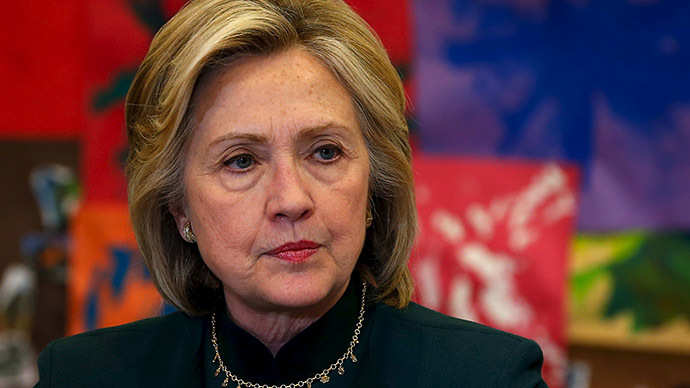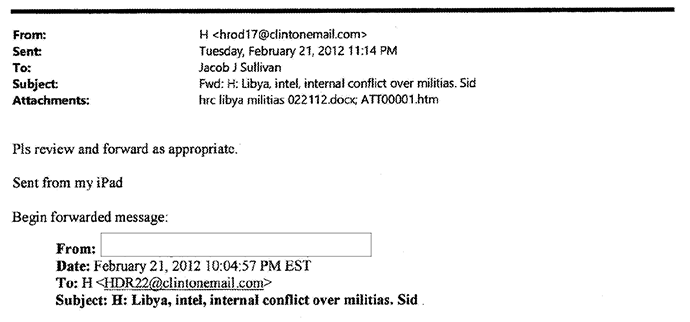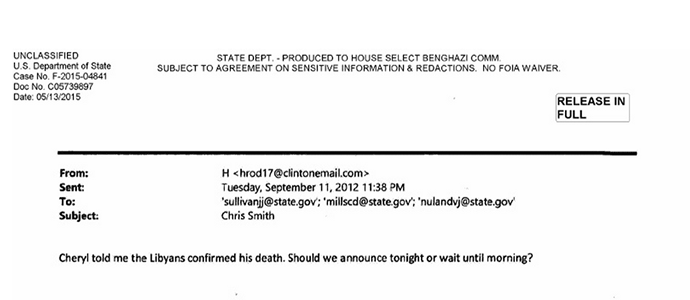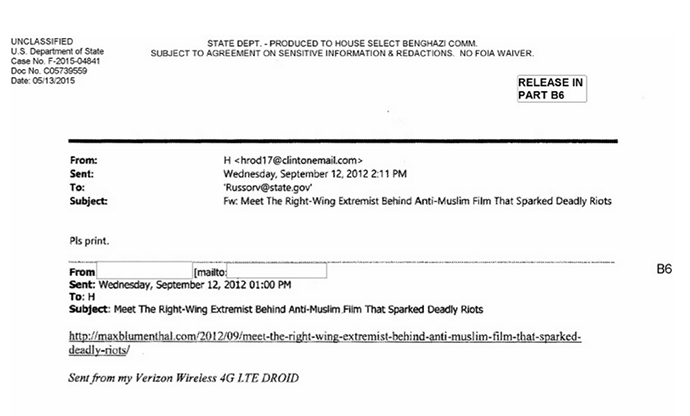Benghazi, memes & more: 9 revelations from Hillary Clinton’s emails

The US State Department released the first batch of emails sent or received by former Secretary Hillary Clinton in 2011 and 2012. Totaling 842 printed pages, the 296 messages are heavily redacted, but some things can still be gleaned from their content.
‘Hrod17’ and ‘Pls print’
Hillary Clinton admitted in March that she used her personal email system, supposedly set up for her husband, former President Bill Clinton, because it was “effective and secure.” The address Clinton used was 'hrod17@clintonemail.com'.
Clinton’s close aide and confidante Huma Abedin also had access to the same email system. In addition to her official address (AbedinH@state.gov), the batch contains at least one email from 'huma@clintonemail.com'.
Many of the emails sent by Clinton contain just two words: “Pls print.”
This pops up dozens of times. Wonder if Hillary considered the environment? pic.twitter.com/HmiluYoXyU
— Matthew Keys (@MatthewKeysLive) May 22, 2015
Not very good at memes
In an email to two of her deputies, William Burns, Deputy Secretary of State, and Thomas Nides, Deputy Secretary of State for Management and Resources, dated December 20, 2012, Clinton mangled a popular meme:
“I’ll be nursing my cracked head and cheering you on as you ‘remain calm and carry on’!”
iPads and Droids
Clinton had told reporters in March that the reason for using her private email address was “because I thought it would be easier to carry just one device for my work and for my personal emails.”
Yet a February 21, 2012 email to Jacob Sullivan, her Deputy Chief of Staff and Director of Policy Planning, ends with “sent from my iPad.”

Another automated signature line helps identify Sidney Blumenthal, a former Bill Clinton aide working for the Clinton Foundation at the time, as the sender of several messages: “Sent from my Verizon Wireless 4G LTE DROID.”
Though Blumenthal’s name and address are redacted on all of them, one of the messages contains the words: “Helpful article. Sid.”

The other Libya film
At 5:50 am on September 11, 2012, hours before the attack in Benghazi left two US diplomats and two security contractors dead, Clinton sent a request to Abedin and another aide, Philippe Reines:
“Can you get us a copy of Bernard Henri-Levi’s film about Libya? I think Harvey made it and showed it at Cannes last spring.”
According to The Daily Caller, the request refers to “The Oath of Tobruk,” a documentary in which Clinton made an appearance. The film praising the US intervention in Libya was directed by French philosopher Bernard-Henri Lévy and brought to America by movie mogul Harvey Weinstein.
Concern for ‘Chris Smith’
An email from the evening of September 11, 2012 indicates Clinton was possibly confused as to who had been killed in Benghazi. The 11:38 pm note asks Sullivan, Chief of Staff Cheryl Mills, and Victoria Nuland, State Department spokeswoman at the time, about “Chris Smith:”
“Cheryl told me the Libyans confirmed his death. Should we announce tonight or wait till morning?”

The slain ambassador’s name was J. Christopher Stevens. There was a Sean Smith who died in the Benghazi attack; he was an information management officer with the US Foreign Service.
Blumenthal’s briefings
Many of the documents released in this batch, the first set of the reportedly 55,000 messages expected to be made public eventually, contain intelligence briefings written by Sidney Blumenthal, with Clinton’s instructions to Sullivan to forward them as appropriate.
A May 2, 2011 email from Blumenthal cites “sources with access to the leadership of the Libyan rebellion’s ruling Transitional National Council (TNC)” worrying “about the reaction to the death of Bin Laden among rebel fighters and their supporters in Libya and Egypt, where the al Qa’ida leader was very popular.”
“These TNC officials do not want the death of Bin Laden to affect their relations with the West or their support from NATO, the U.S., France, or Great Britain,” Blumenthal wrote.
Another email, however, cites Libyan fears that France and the UK were working to break up the country. “This one strains credulity,” said Clinton of that memo, dated March 8, 2012. “Seems like a thin conspiracy theory,” added Sullivan.
Libyans didn’t blame the YouTube clip…
A memo from Blumenthal, time-stamped 12:50 am on September 12, 2012, says the Libyan leader at the time, Mohammed Yousef el-Magariaf, alleged his political opponents were trying to paint him as a CIA puppet. The September 11 attack on the US mission in Benghazi was “as much a result of the atmosphere created by this campaign, as the controversial internet video,” according to a “sensitive source” cited by Blumenthal.
In another report, sent at 6:16 pm the same day, Blumenthal cited sources within Libya again:
- “Libyan security officials believe that the attack was carried out by forces of the Islamist militia group calling itself the Ansar al Sharia brigade; working out of camps in the Eastern suburbs of Benghazi.”
- “The officials believe that the attackers having prepared to launch their assault took advantage of the cover provided by the demonstrations in Benghazi protesting an [internet] production seen as disrespectful to the prophet Mohammed.”
- “Some of the Libyan officials believe that the entire demonstration was organized as cover for the attack, however; they point out that there is no evidence of such a complex operation at this time.”
- “In the opinion of this individual, Libyan security officers also informed el Magariaf that the attacks had been planned for approximately one month, based on casing information obtained during an early demonstration at the U.S. consulate in Benghazi. The attackers were, in the opinion of these individuals, looking for an opportunity to approach the consulate under cover in a crowd.”
Clinton responded with “Pls print.”
…Max Blumenthal, however, did
In between those two reports, Blumenthal sent Clinton a one-line email at 1 pm. It contained only a link to a website run by his son Max and had the subject line: “Meet The Right Wing Extremist Behind Anti-Muslim Film That Sparked Deadly Riots.”
The sender and address were redacted from the release, but the email bears the telltale signature of Sidney Blumenthal’s Verizon Wireless phone.

The following day, Max Blumenthal published an op-ed in the Guardian blaming the “rightwing extremists” who made the film for the deaths in Benghazi.
Arguing the video
Every page of the emails featuring the draft statements pertaining to the Benghazi attacks has been redacted. However, a September 24 email from Clinton’s Deputy Chief of Staff Jake Sullivan outlines the shape of the spin Clinton and her aides were putting on the attack.
Discussing an opinion piece by Bill Keller - “The Satanic Video” in the September 23 edition of the New York Times - Sullivan cites an argument “that worked on my conservative Obama-hating (Hillary-respecting) friends,” in a September 24, 2012 email.
The denunciations of the video, Sullivan argues, “aren’t an effort to debate the mob; they are an effort to give ammo to the right side to win the battle that Keller himself identifies (between extremists seeking to put ‘pressure’ on weak transitional governments and the more mainstream majority that supports those governments). And you could say it worked.”
“So we need to make this argument forcefully,” Sullivan concluded.
Of course the State Department releases first batch of Hillary Clinton emails on Friday afternoon of a three-day weekend. Typical.
— Katie Pavlich (@KatiePavlich) May 22, 2015
The full text of the 296 emails can be read online here, or downloaded here.











